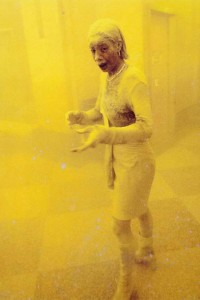Of the hundreds of thousands of photographs that were made in New York City on September 11, 2001, many of them resonated with people for different reasons. The images of the aircraft hitting the Twin Towers, the towers burning, of humans falling from them, and of their ultimate collapse all caused horrified reactions from those who saw them. But there was one picture taken that day which resonated on a profoundly human level, that reduced the event to the intensely personal, and that somehow reflected the shock and paralysis that so many felt at the time. That picture, later titled "The Dust Lady", was taken by a photographer from the Agence France-Presse, Stan Honda, and it was of a woman named Marcy Borders, who worked at that time as a legal assistant at the Bank of America.
 As film director Errol Morris wrote about documentary filmmakers Albert and David Maysles, "The role of documentary film is not to give us reality on a plate. We have plenty of our own reality to deal with. It should make us think about reality." The photograph of Marcy Borders that was taken on 9/11 certainly did that, and more.
As film director Errol Morris wrote about documentary filmmakers Albert and David Maysles, "The role of documentary film is not to give us reality on a plate. We have plenty of our own reality to deal with. It should make us think about reality." The photograph of Marcy Borders that was taken on 9/11 certainly did that, and more.
Ms. Borders died in mid-2015 and the New York Times Magazine ran a memorial article on her that is well worth reading. Although she became an iconic figure for many because of The Dust Lady photograph, the New York Times article reminds us that every person in every photograph has a story that no photograph can ever tell.
We are all more than what we look like or what we show of ourselves in photographs.